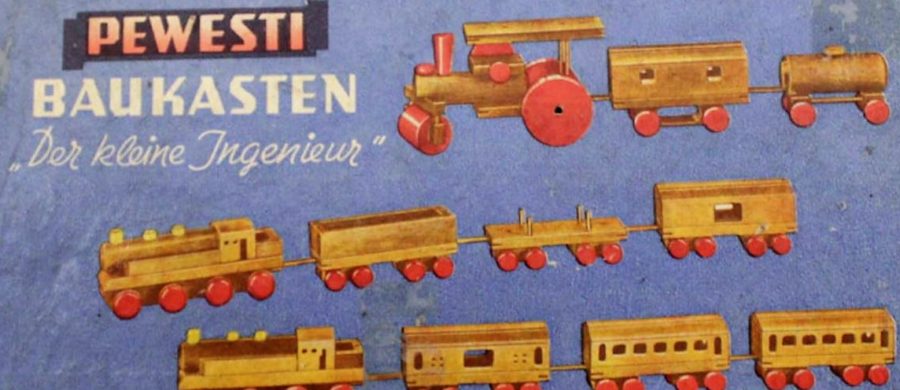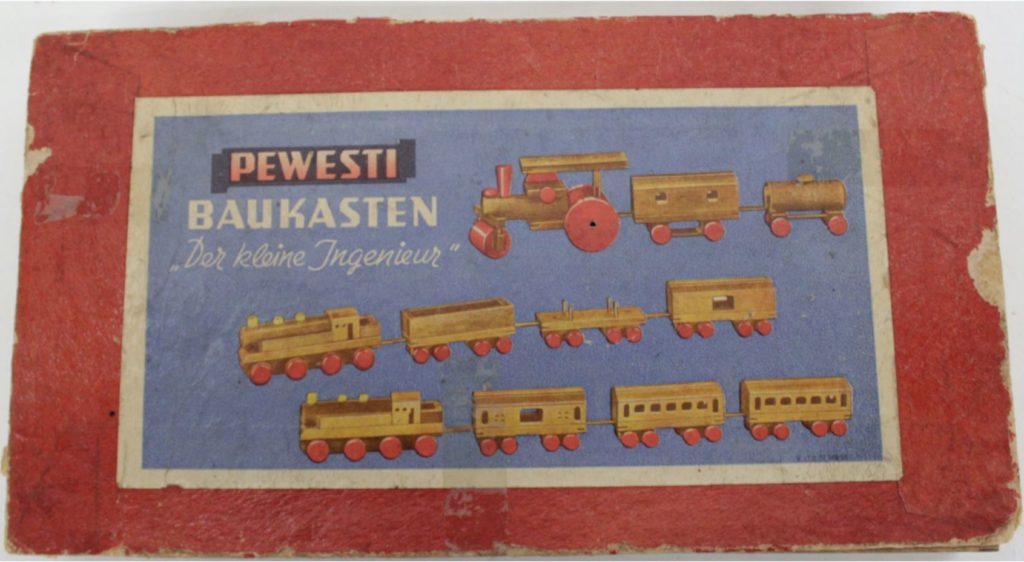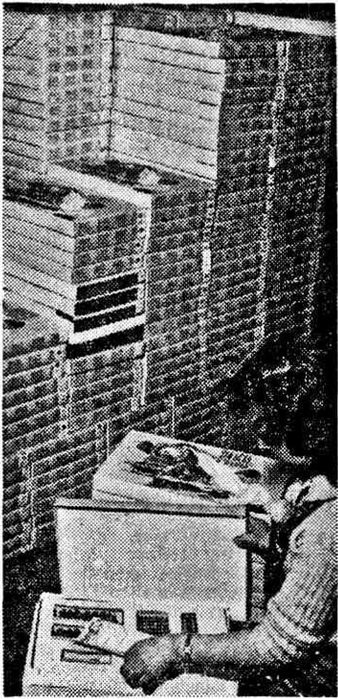
Women on the Right Track: Integrating Women into the Communist Technological Utopia
Technology’s Stories vol. 5, no. 4 – DOI: 10.15763/jou.ts.2017.12.04.03
PDF: Bianchini_Women on the Right Track
In 1950, the fledgling German Democratic Republic (GDR) held a small exhibition in Jena featuring a miniature town contained within a glass case, war torn Germany rebuilt in socialist splendor, train tracks its veins. So soon after the decimation of the war, this exhibition trumpeted the reconstruction of Germany under socialism. The miniature town attracted the attention of many journalists. Writing for Neue Zeit, one of them noted the excitement of the children, the adults, of everyone, as the trains whipped around mountains, charged through tunnels, chugged ceaselessly through town and landscape. But beyond the jubilation in the face of a rebuilt homeland, the journalist noted a different sort of excitement. They wrote, “With this exhibition, the public interest in technology shall be awoken, particularly among woman and girls.” This moment, so early in the history of East Germany, portended the state’s drive to outpace the West by way of technological advance. It also marked a realization that model trains could be the spark to ignite a technological impulse in budding comrades. And, for the first time in German history, that the ranks of technical professionals would include women and girls.[1]
The task of developing technological prowess loomed heavy for East Germany. While perhaps true for all countries that found themselves drawn into the Cold War, East Germany’s unique position as the literal dividing line between capitalism and communism lent additional urgency to technological development. Thus, catching up and surpassing the West was of the utmost importance. Following the Second World War, technology achieved almost messianic status for the reciprocal sides of the iron curtain. Humans and satellites were launched into space; nuclear weapons were stockpiled; cars became emblems of achievement. East Germany was no exception. The GDR came to see computers, cybernetics, and the chemical industry as the harbingers of the communist technological utopia. To them, this utopia was the logical conclusion of the efforts of communism. The drudgery of work would be eliminated, replaced with the advent of fully automated communism.[2]
As a result, the state’s enthusiasm for technology seeped into their very culture, with film and fiction touting the values of a new era, stamps adorned with cameras and rockets, the television tower bisecting the Berlin skyline, and education laws written in service to the technological revolution.[3] Through this media, the state asked the people to look toward the future, toward a better tomorrow. But if this technological utopia was actually to be built, the state needed a whole new crop of young engineers. Thus, the technological arms of the state, such as the Kammer der Technik, sought a toy that would both impart the knowledge and skills of engineering while allowing for the deployment of the rhetoric and world building their grand designs required.

Figure 1. A Pewesti wooden train kit. Aimed at younger children, the slogan reads “Der kleine Ingenieur” or the little engineer. Picture courtesy of the Wende Museum.
This confluence they found in train modeling kits. Fascination with trains has long stood as a uniquely German trait. Stretching back to the opening credits of the film Berlin: Die Sinfonie der Großstadt, where both the train and the city reflect the pinnacle of German achievement, trains have appeared as the objects of German fascination and study.[4] Their native popularity made models ideal for widespread distribution of state approved rhetoric. Train sets also allowed the child to play engineer and design the state in miniature. (Figure 1) Here the child too would learn the logics of geometry and spatial relations necessary for a career in engineering. The idea was straightforward; interest in model trains would lead to interest in engineering. While this might seem simplistic, this A to B logic is now present in the rhetoric surrounding Lego, who also are quick to assure parents and kids alike that the toy fosters the logic and skills necessary for an engineer. Because the state saw these traits inherent to train modeling, and because the state was enacting several measures to integrate women more fully into the pedagogical manifestations of their longing for utopia, model trains also became a site for gender rebalancing.
East German trains, produced mostly by VEB PIKO, were small, colorful, and realistic. Kits, such as the PIKO “Expert”, were outfitted with track, wiring, one locomotive, and three passenger cars. Of course, more industrial kits featured tankers, coal cars, and the like. And while models of former trains were available, most of PIKO’s production featured models of the current German railroad. PIKO, short for Pionier Konstruktion (Pioneer Construction), was largely started as an Eastern answer to the Trix, a Western model of the same era. With the calcification of the Cold War and the currency reform of the West, Western models became scarce and expensive. Thus, PIKO trains followed the shape and form of their western cousins, built on the same H0 gauge. PIKO was tasked with filling the demand for toy trains throughout the Eastern Bloc, its models appearing in Russia and beyond.
Furthermore, the train modeling kit also served as an ideal platform for the state to expound on both the potential and necessity of technology. Take, for example, this excerpt from the instruction booklet for the PIKO dat, a computer toy meant to integrate with model train sets:
In a time where airplanes fly over continents at supersonic speeds, where science and technology are developing wildly, man must equip himself to reach for the stars. Never before has man held at his disposal such an abundance of insight, knowledge, and experience as in our time. But in order to solve the remaining complicated tasks of science and technology, new tools must be created. Tools that allow man to unshackle his thoughts from routine work in order to focus them instead on further creative development. One such tool is the COMPUTER. For this reason the state enterprise PIKO has created a device that is both computer and toy: the PIKO dat. The PIKO dat fosters knowledge impartation as well as logical reasoning through play and allows users to put their own ideas into practice, all while teaching the most important foundations of computer engineering. Prestigious experts, experienced teachers, scientists, engineers, and technicians of our people’s industry created this modern toy that corresponds to our time.[5]
Model train kits also served to address another goal of communism: the equalization of men and women. East Germany had its own unique gender politics, one in opposition to its Western counterpart, Nazi past, and reunified future. State officials believed that by barring women from work, the capitalists were letting half of their workforce lay fallow. Only the joint might of men and women could unleash communism’s full potential. The East did indeed take seriously the goal of gender equalization. As historian Dagmar Herzog succinctly phrased it: “The difference lay in the combination of institutional structures and strong rhetorical support in the East, which made woman’s work for wages not only possible but also much less guilt inducing.”[6] In Sex After Fascism, she argued that East Germany did not need the Sexual Revolution of the West; they had already provided women with the rights of communism. Women were seen in positions of power in higher numbers than the West, particularly in technical careers; women received the same levels of education and training as men; and it was the women, not the men, who were the true heroes of the East German Olympic teams. Furthermore, the state advocated for safe pre-marital sex, upheld the right to abortions, and granted free childcare, thereby reducing the home labor that so often fell on the shoulders of women.[7] Given this background, as the pedagogical potential of the train set became clear, trains became a way to introduce young girls to the world of engineering. The GDR used the inherent socialization of play to include, rather than exclude, young girls in technological play with the hopes that they, too, would grow up to join the ranks of the technocrats.[8]
This was not to say that the transition was instantaneous. What had so recently been a Nazi state invariably housed regressive gender sentiments. For example, a Neue Zeit article from 1954 stubbornly insisted, “trains are to boys both big and small, as dolls are to girls grown and young.”[9] Early advertisements for PIKO featured young boys grinning up at their male mentors. The PIKO dat’s tagline, “What Hans will one day need, little Hans can learn today with the PIKO dat,” featured a Hans rather than a Hanna.[10]
As gender assumptions gave way through strong rhetoric and practical policy, the train became a tool of inclusion, and women became an important consideration for the state. In 1953, a group of about 70 children gathered in East Germany’s Pioneer Park, each awaiting the reward for their hard work. They grew restless as Kurt Freitag, vice president of the East German state railroad, talked to the journalists gathered there. He spoke of the importance of what these children were doing, how their work differed from the capitalist fantasies of the past, and how such work would serve the noble goal of getting more children interested in technical careers. Finally, the moment of celebration had arrived. Before the youth group gathered around him, Freitag declared a new joint venture between the state railroad and what he termed the “young railroaders.” The exhibition stood testament to this new unity, itself a large model train landscape built by the young railroaders with the guiding hand of state railroad experts.[11] However, what was most noticeable to the journalists gathered there were the words of a single twelve-year-old girl. “One day I would like to become a railway station manager,” she said unprompted. [12] After having been invited to work on the exhibition with other boys and girls, she saw herself remaining in the realm of railroads. This was evidence to the state that modeling could and would lead to technical careers.
By 1965, the state was fully invested in the integration of women and girls into the technical workforce. For example, the 1965 School Law’s 36th protocol decreed, “the education of women and girls for technical careers shall receive dedicated concentration.” Indeed, the state demanded that education operate in service to the coming technological utopia. Such a utopia would be impossible, the law’s drafters had reasoned, without allowing women to reach their full technical potential unimpeded by regressive gender roles.[13]

Figure 2. A PIKO advertisement featuring a young girl unboxing a train set. Photo courtesy of Staatsbibliothek zu Berlin.
Accordingly, advertisements for PIKO began to feature girls opening their train kits rather than boys. (Figure 2) Furthermore, the GDR proudly touted other toys as pathways toward technical careers. Dolls were recast to depict careers for women, rather than housewives or materialistic Barbies. East German dolls were refashioned to reflect women as members of the industrial workforce. Girls could now play with a steel worker, a tractor driver, or a farmer in her work attire.[14] This was seen as a direct intervention in the gender politics of play: “These dolls bring the social equality of women directly to the child at play. Furthermore, construction kits and learning toys of all kinds should no longer merely be for boys, but also for girls in order to point them on their way to technical or construction careers early on.”[15] Thus, toys, and in particular trains, were seen as an ideal and practical way to include women in technical careers that had previously been barred to them.
Thus, these toys are emblematic of the East German efforts to recruit women into their technological culture. As the state looked to activate what it had termed the “scientific-technological revolution,” it saw women as integral to their efforts. For the next few years, it seemed as if the state’s efforts had worked. The GDR implemented free daycare for women to help alleviate the double burden of work for wages and the labors of the home. Women often married for love rather than for monetary dependence, calling for divorces when the love expired.[16] And all the while, women found true careers in engineering, on the same footing as their male counterparts. Indeed, the number of employed women with engineering degrees had almost tripled from 1950 to 1971.[17] But this was not to last. At the time of the reunification, many hoped that the melding of the two Germanys would be just that: a true mixing of the best parts of both. Instead, the West merely consumed the East, returning to the gender relations of old. Marriages fell apart, engineering jobs dried up. Yet for a brief moment, it seemed like the state was taking seriously one of the promises of communism, that of gender equality.
Mario Bianchini is a PhD student in the History and Sociology of Science and Technology at the Georgia Institute of Technology. He is currently a fellow at the Zentrum für zeithistorische Forschung Potsdam through a DAAD grant. His research explores the technological culture of East Germany.
Suggested Readings
Dagmar Herzog, Sex after Fascism: Memory and Morality in Twentieth-Century Germany (Princeton: Princeton University Press, 2007).
Paul Betts, ed., Within Walls: Private Life in the German Democratic Republic, (Oxford: Oxford University Press, 2012).
[1] “Eisenbahnwagen und Lokomotiven in Glassschränken,” Neue Zeit, December 16, 1950, ZEFYS/DDR-Presse, 4.
[2] For a few examples of this attitude, see: Raymond G. Stokes, Constructing Socialism: Technology and Change in East Germany 1945-1990 (Baltimore: Johns Hopkins University Press, 2000); Andreas Ludwig. ed, Fortschritt, Norm und Eigensinn: Erkundungen im Alltag der DDR (Berlin: Ch. Links, 1999); Paul Betts, ed., Within Walls: Private Life in the German Democratic Republic, (Oxford: Oxford University Press, 2012); Kristie Macrakis and Dieter Hoffmann, eds., Science under Socialism: East Germany in Comparative Perspective (Cambridge: Harvard University Press, 1999).
[3] Harald Rockstuhl, Schulgesetz der DDR 1965-1991/1992 Gesetz über das einheitliche sozialistische Bildungssystem der DDR vom 25. Februar 1965 (Bad Langensalza: Verlag Rockstuhl, 2013).
[4] For some examples of German train fascination see: Walter Benjamin, The Arcades Project(Cambridge: Harvard University Press, 2002); Wolfgang Schivelbusch, Geschichte der Eisenbahnreise: zur Industrialisierung von Raum und Zeit im 19. Jahrhundert, 5. Aufl., Lizenzausg, Fischer 14828 (Frankfurt am Main: Fischer-Taschenbuch-Verl, 2011); Thomas Mann, Das Eisenbahnunglück: Novellen, 1-4. Tsd., Serie Piper 868 (München Zürich: Piper, 1988).
[5] PIKO dat Instruction Booklet, 5.
[6] Dagmar Herzog, “East Germany’s Sexual Evolution,” in Socialist Modern: East German Everyday Culture and Politics, ed. Katherine Pence and Paul Betts, Social History, Popular Culture, and Politics in Germany (Ann Arbor: University of Michigan Press, 2008).
[7] Dagmar Herzog, Sex after Fascism: Memory and Morality in Twentieth-Century Germany (Princeton: Princeton University Press, 2007).
[8] For more on the gender politics of East Germany, see: Dagmar Herzog, Sex after Fascism: Memory and Morality in Twentieth-Century Germany (Princeton, NJ: Princeton Univ. Press, 2007); Paul Betts, ed., Within Walls: Private Life in the German Democratic Republic, (Oxford: Oxford University Press, 2012); and Rita Aldenhoff-Hübinger, “Die Ausstrahlung der ‘Halbleiterpflaume'” in Fortschritt, Norm und Eigensinn: Erkundungen im Alltag der DDR (Berlin: Ch. Links, 1999).
[9] “Internationale Zuversicht in Unsere Wirtschaftliche Kraft,” Neue Zeit, September 11, 1954, ZEFYS/DDR-Presse.
[10] “Oldtimer Zum Selbstbauen,” Neue Zeit, September 7, 1969, ZEFYS/DDR-Presse.8.
[11] “Ich werde dann Lokomotivführer,” Berliner Zeitung, February 17, 1953, ZEFYS/DDR-Presse, 6.
[12] Ibid. 6.
[13] Rockstuhl, 67.
[14] Was die kindliche Phantasie beflügelt / ZEFYS/DDR-Presse • Neue Zeit, Mi. 21. Januar 1953, Jahrgang 9 / Ausgabe 17 / Seite 3
[15] Ibid.
[16] Herzog, “East Germany’s Sexual Evolution.”
[17] Dolores Augustine, “Frustrated Technocrats: Engineers in the Ulbricht Era,” in Science under Socialism: East Germany in Comparative Perspective, ed. Kristie Macrakis and Dieter Hoffmann (Cambridge: Harvard University Press, 1999).
